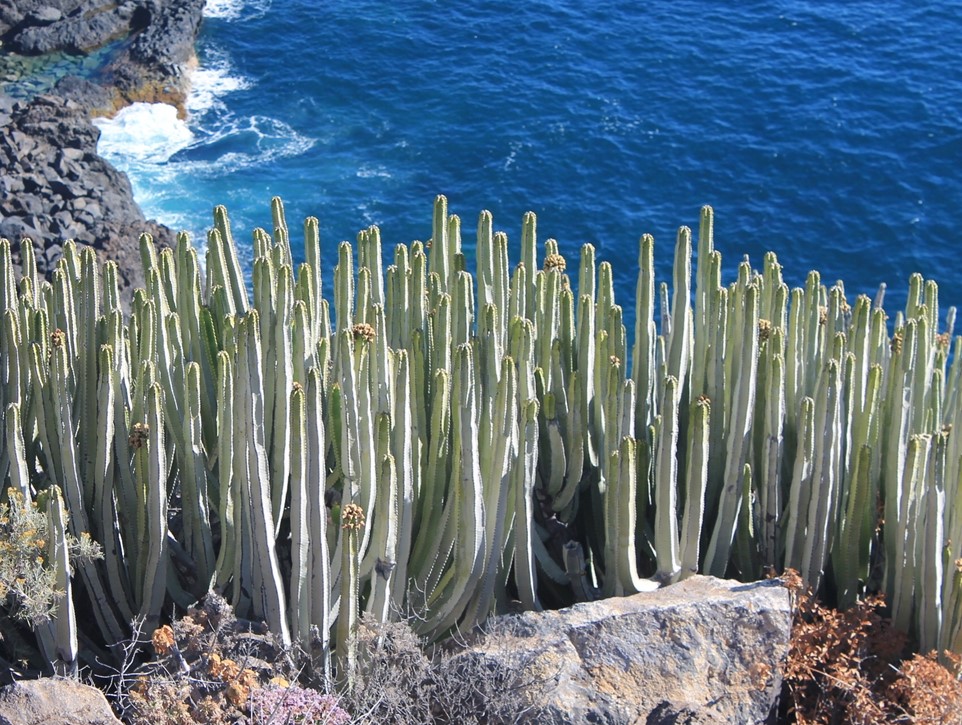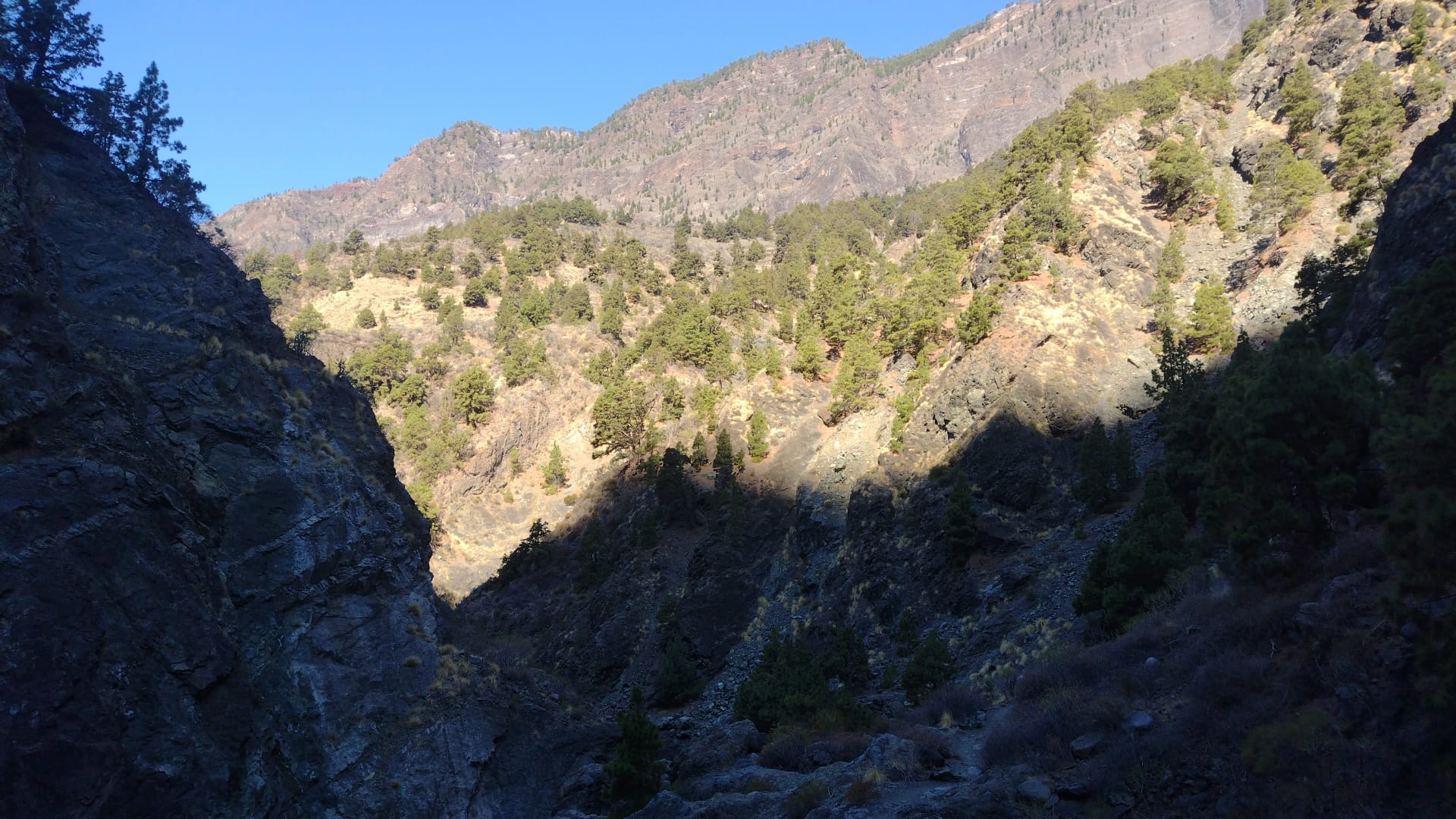And there it was! The same hump of succulent, twisted, dusty-green tubes nestled into a hillside of purple-brown lava, and standing proud against a pale blue backdrop: part sea, part sky, it was difficult to tell where one ended and the other began. I spied it as I rounded a sharp bend, just as I had six years ago, and the recognition was instant. That’s my cactus!
When six participants from the ‘Discover Morocco’ trip in 2023 decided they’d like to travel together as a group again, and asked me where I’d take them if they wanted a two-week painting itinerary somewhere I thought they’d like, I had little hesitation. It had to be the Canary Islands, and the ‘Mists of Time’ itinerary in La Gomera. But with three of them travelling from the United States (including Alaska) and one all the way from Australia, a paltry week wasn’t going to be enough. There was only one thing for it: I’d take them ‘next door’, to the larger, even more dramatic island that I’d previously poo-pooed for a painting holiday. The challenging complexity and relative inaccessibility of its still-active volcanic peaks, and my previous failure to identify an obvious place to stay had placed it on the back-burner, in the category of ‘maybe later, when I have time to think about it’.
I’m talking, of course, about La Palma, and they jumped at the opportunity, so I set about designing an itinerary which would take in all the views I had swooned at, and wished I’d had the chance to capture properly, during my last visit.
I’m very strict about never taking anyone anywhere I don’t know extremely well, if not intimately, so this trip would be undertaken on the understanding it was somewhat experimental. We’d drive ourselves, in the absence of a known transport company, so I needed someone to volunteer as second driver, and Helen stepped up. La Palma is not a huge island, but it’s considerably larger than La Gomera, and thus it requires longer to get from one jaw-dropping beauty spot to another. I decided to spend time in two locations and stay in three hotels, to avoid wasting more time than was necessary in the vehicles, and to get an overview of accommodations available.
It all worked out pretty well, and although a few elected not to join the longer, rougher walks, they all loved the capital – Santa Cruz – and produced several fabulous sketches of the old town. Each of the hotels were good in their way; particularly in Los Llanos, which boasts a jacuzzi pool on the roof terrace, and coffee which I declared the best in the Canaries. We found a viewpoint for the new volcanic cone, which erupted three years ago and still has wispy smoke eminating from around the edges, and some ancient petroglyphs that I had not previously known of. The world-renowned observatory, passed en route to the indescribably beautiful view at El Roque de los Muchachos (the boys’ rock), now has a small interpretation centre complete with lecture theatre, which I will be sure to factor in another time. The only disappointment was that the car parking for the viewpoint at La Cumbrecita, for the tree-covered slopes of the Caldera de Taburiente, must be booked in advance, and we were turned back. However, this worked in our favour as we enjoyed perfectly clear skies in contrast to the low cloud which had descended the day before.
I had been dying to return to La Palma ever since my last visit, in 2018. With regular trips to La Gomera, usually followed by one to Morocco and then a regular work schedule to squeeze in, a return for pure pleasure wasn’t practical. Now, however, I was excited to be back and I was instantly flooded with half-forgotten memories and the same feeling of peace I experience when the ferry docks in La Gomera. At once familiar, these islands feel as unique and remote as they indeed are, sitting way out into the Atlantic, close to nothing except an adventurous heart.
As we drove around, I felt my smile broadening at small recognitions: a junction here, where I paused in indecision; a small roadside cafe there, where I sat in warming winter sunlight sipping a bitter espresso. Plant milk had not quite made it to La Palma on my last visit. The walk up the barranco towards the Cascada de los Colores (‘Waterfall of Colours’, so named for the unusual, striped rock face over which the water plunges – or trickles, depending on the season) was the day I was most longing for. To the intrepid who joined me, I pointed out the small hostel, perched high on the sides of the canyon and still in deep shadow until the early sun crept over the crater rim, where I stayed for four unforgettable days before reluctantly deciding it wouldn’t be the right place to bring painting guests. They agreed, after observing how steeply the road climbed up to reach it and how precipitously it clung to the hillside. The wild, untamed face of La Palma is not for everyone.

On our last day, when I had succeeded in wearing the rest of the group out and I was the now the only one with the urge to whizz around discovering (or, in my case, rediscovering), I took a final drive up the coast to Charco Azul for a refreshing dip in the turquoise rockpools. On the way I detoured through San Andreas and smiled again at the memory of a sleepy village built on a slope; its colourfully-painted walls aflame with bouganvillea, and a welcoming cafe full of crinkly-eyed, elderly gentlemen whiling away their day. This was one of the places, I realised, in which I had begun to feel the magic.
An accidental turn down a long, narrow road of endless hairpin bends brought me to a viewpoint high above Playa Nogales, a somewhat hidden cove of dark brown sand backed by steep cliffs and ringed with prickly pear. As I approached the parking area I saw it. At once I remembered, and I knew. This was the cactus I couldn’t resist stopping to paint on the final afternoon of my first visit; a splodge of green-on-blue, the result looks like nothing, yet signifies everything. This was where it got me, where the island had me in its spell. This bend in the road, insignificant to most but sporting a very fine euphorbia, was the last of my ‘falling places’.

